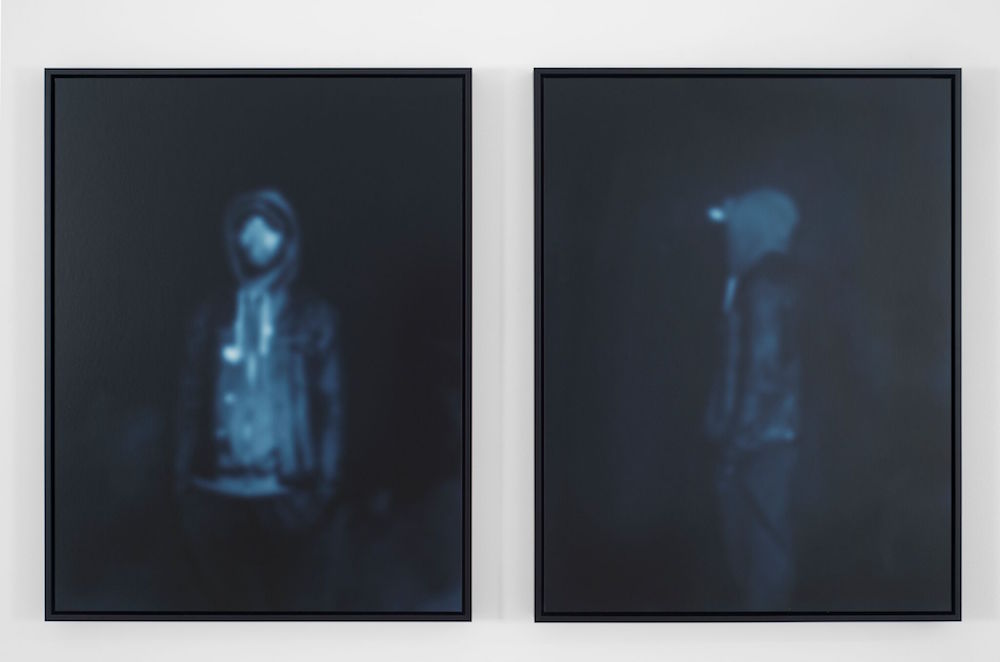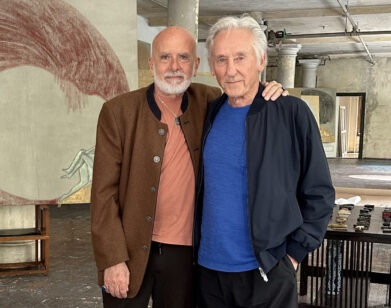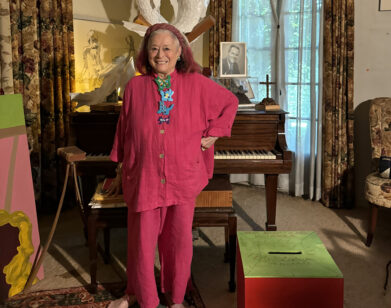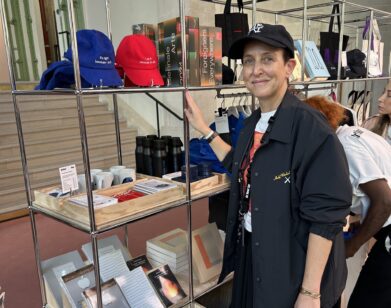Carrie Mae Weems and a Shifting Stage
A woman in a black dress guides you through film and television sets, her figure always silhouetted and always alone. Alongside one image of this woman in a library, text reads: “In suspended disbelief, she floats from room to room and set to set, marking the shifts that seemed to reset the bar—hmm, shows exploring the outer limits of blackness and its ability to hold the imagination.”
Titled Scenes & Take (In Suspended Disbelief) (2016), this piece is from Carrie Mae Weems’ newest body of work: “Scenes & Take.” She likens the series to an accordion that’s still unfolding, revealing more layers and more complexities. Empire, How to Make a Murderer, and Scandal—shows that all have black female leads—are some of the television sets that this figure is visiting. She’s standing in what seems a representational shift in the entertainment industry—perhaps a more nuanced one. Weems says that even some of the directors she admires most have “never had a black woman in the main role, or for that matter, in the background.” She continues, “I’m interested in looking at those tensions between what has happened in Hollywood, film, and TV and what is going on now. What are the shifts that are taking place now?”
In addition to the current first showing of “Scenes & Take” at Jack Shainman Gallery’s 20th Street location in New York, Weems’s work now also fills Shainman’s 24th Street space with pieces spanning back to 2012. It’s the MacArthur “Genius” Fellow’s first solo show in New York since her 2014 Guggenheim retrospective.
Interview spoke with Weems last week about how figures in pop culture, Hollywood, and art history inform her practice.
TESS MAYER: I love the “Scenes & Take” series. It seems to me like it references your “Roaming” [2006] series.
CARRIE MAE WEEMS: I think so. Somebody made the wonderful observation yesterday, that I was hoping somebody would at some point, that they realized it was very similar in a lot of ways to “The Kitchen Table Series” [1990].
MAYER: I read a great interview you did with Dawoud Bey for BOMB, and when you spoke of the “Roaming” series you said, “She is a black woman leading me through the trauma of history … She’s a guide into circumstances seldom seen.” I wonder if you see that as true in your work with film sets?
WEEMS: Oh, I think so. She really functions as this muse that I’ve developed that is functioning very much in the same way. Except, of course, in this context she is looking at the history of representation for black women, brown women, Asian women in film and TV. So it’s moved from the overtly political. I’m looking very specifically at the way in which the figure has been literally inscribed in TV and in popular culture, with the one caveat being that now we’re really looking at something that has another kind of tension to it. I was really looking at shows—Scandal, Empire, How to Get Away with Murder—which are shows that have black women specifically in the lead, which is something new on the landscape. Of course we could talk about Julia from the 1960’s who was a black nurse, or some of the Norman Lear projects like The Jeffersons; those are some very different kinds of shows. They were shows that brought forth very specific social issues that were very, very important. In fact, I’m in touch with Norman Lear now. This looks at the shifting landscape of TV; shows like Scandal, How to Get Away With Murder, Empire, they’re not only starring women of color, but also are introducing us to a whole landscape of what could happen in TV vis-à-vis pop culture or hip-hop culture. So you have the use of graffiti, you have mid-century modernist furniture, you have incredible contemporary art by some of the most successful and important African American artists of our day, all in the same sort of environment.
MAYER: You reference several artists in the titles of the works, specifically these figures in art history. Three photos mention: “See Mendieta.”
WEEMS: Oh, I love those pieces from the “Equivalents” [2012] series. It references Stieglitz, Steichen, Lorna Simpson, Ana Mendieta, Kerry James Marshall, and Duchamp—people I’ve long admired. You know, artists are influenced by other artists. We’re all deeply influenced by what’s around us; we don’t make anything cold. Sometimes we think that we do. But within that, the most important part is that even though we’re influenced, what are the levels of invention that we carry forth even as we’ve been influenced by something that’s come before?
MAYER: How do you see Ana Mendieta in your work?
WEEMS: She’s influenced me by really laying bare her body, by the extraordinary courage in laying herself open to the world—in saying, “Here it is.” It lies in all these spaces, whether she’s lying in a garden, in a garbage dump, or on a beach. I have thought about her often.
Felix Gonzalez-Torres, I think of him often. Works by Lorna Simpson, I think about her often—I wish I had made it myself. In a way what I decided to do was to actually make them, and in some cases to make them because I wanted the process of experiencing what it would look like to feel in making it. And also to see it with my own eyes, and knowing it would be different, knowing that the inscription would be different. I think of Duchamp constantly even though he never considered me. His famous piece that is at the Philadelphia museum [Given: 1. The Waterfall, 2. The Illuminating Gas (1946-1966)] is what The Broken, See Duchamp is based on. His piece is based on Courbet’s piece The Origin of the World [1866], but yet there’s this sort of invention. What Courbet does is lay bare this unbelievable vagina—this is 1860 or some shit—it’s amazing that he did that when he did it! Duchamp is coming 100 years later, and now that body is desperate. It is broken and destroyed and tossed aside. And you can look at them in proximity to each other.
MAYER: In “Blue Notes” [2014-2015] these blocks of primary colors obscure recognizable pop culture images. It reminded me of a television screen. I could really only identify Basquiat and Mick Jagger behind the color blocks, but I knew I had seen all the images before and they were just too obscured to exactly tell. Could you talk about your process behind that work?
WEEMS: I’m really glad you hit on the idea that there’s this sort of primary color blocking out the image; in part it’s absolutely meant to do that. I often think about people living behind walls and veils of color that block us from knowing who they are, from accessing them, from equity, from equal rights, etcetera. There’s Lisa Fischer who’s with Mick Jagger, who was really the anchor for the Rolling Stones … These are extraordinary artists who laid down the template so that these men could actually do what they do. They used their bodies, they used their voices, and they used their brilliance. And those men used them specifically for that purpose. Mick Jagger would not be Mick Jagger without Lisa Fischer holding down those notes, because he really can’t sing, but he is a great performer. Not to take anything away from him, but they went to those women because they knew they needed some badass singers. [laughs] So they weren’t stupid. But now often we don’t know who those women are. Of course this work fits into the “Slow Fade to Black” [2010] and “Colored People” [1989-1990] series. How can we use color to obscure, color to reveal, color to laugh at, and color to love? It’s complicated. It’s not just one thing about blackness. It’s a more complicated thing about vitality and richness of color. What happens when you mix colors? Then you get something new, something more dynamic, something more interesting. I’m interested in those ideas, which lead me to ideas of color theory, color practice. The work is always playing with levels of idea and meaning, it’s never just about race. That would be really fucking boring.
I’m very excited about this. But my influence for this, as much as it comes out of “Slow Fade to Black,” was certainly informed by the film 20 Feet From Stardom [2013]. Thinking about these extraordinary women—I had already done “Slow Fade to Black” before 20 Feet From Stardom came out—but I really wanted to think about those singers in another kind of way.
MAYER: You’re based in Syracuse, right?
WEEMS: Yes, actually I am, though I do spend a lot of time in Brooklyn too. But I live there with my husband Jeff Hoone who is the director of Light Work in the community darkrooms, a photographic organization where I did one of my first residencies.
MAYER: I saw on your website you have this timeline; it says, “Meets Jeffrey Hoone. She sees the future and knows they will marry. He sees nothing.” That was amazing. [both laugh] I’m from upstate New York, so I wonder, how does being mainly based in Syracuse affect how you do things? Is there just more space?
WEEMS: Well, of course there’s more space—New York is so crazy—it’s just like parking your car; three days later you can’t find the car or I got a ticket because I parked it next to something. I love the city. I love the energy of New York and what happens here. But I’m very happy I don’t live in the city on a daily basis, because I really do spend a great deal of my time, when I’m not on the road, in my studio—everyday, everyday, everyday.
MAYER: You have a huge amount of work just from the past year or two up in this show. I was surprised there was nothing from a lot earlier—
WEEMS: Last week! [laughs] I was painting the Basquiat and they were taking the canvas away. I do work a lot.
MAYER: And you had the MacArthur Fellowship a few years ago, and you spoke at the SVA Graduation recently.
WEEMS: I’ve been very busy. Of course I’ve been busy for a long, long time. I’ve received a ton of awards in the past few years … I think they’re really great, it’s really an honor, but shit—I really have to work for these things. You spend three months writing for a lecture. It’s been great to have the work acknowledged, but I’m really looking forward to a time of really quietly working in the studio with nothing to do. The wonderful thing about a show like this is that I know that when I go back to my studio, I already know some of the ideas and some of the issues that I really want to push forward and how I want to make something. I’m just really excited. For me, in a way, this particular work is done. And now—how to explore more fully, more deeply? “Scenes & Take” I think is just the beginning of a process. I started working on “Roaming” and “Roaming” went on for about three years. The “Museum” [2006] series is still going on, I started doing that six or seven years ago; I’m still making images around it. In a way [“Scenes & Take”] is in the same vein; it’s a piece that’s really evolving. It doesn’t have an artificial finish line. It’s about a certain kind of exploration of who—what people, what directors, what films, what literary figures, what political figures—are doing some of the most interesting and engaging work within contemporary culture that we need to focus on. I want to stand at those sites.
CARRIE MAE WEEMS IS ON VIEW AT JACK SHAINMAN GALLERY‘S 20TH AND 24TH STREET LOCATIONS IN NEW YORK THROUGH DECEMBER 10, 2016. FOR MORE ON CARRIE MAE WEEMS, VISIT HER WEBSITE.







